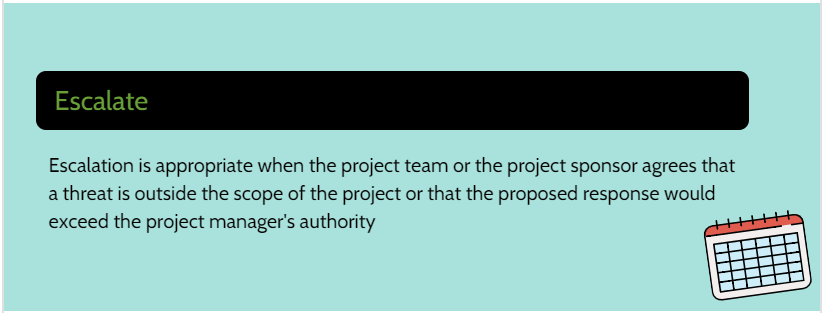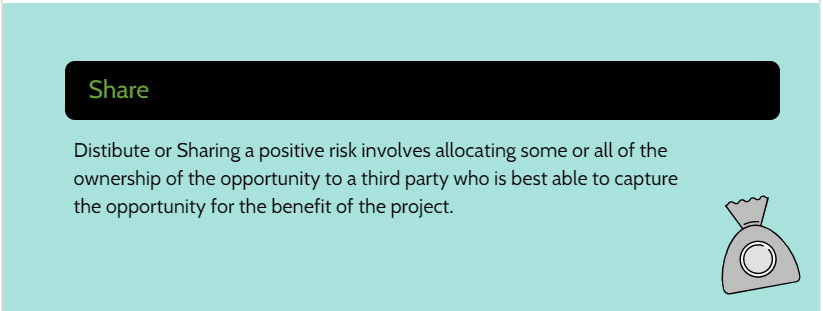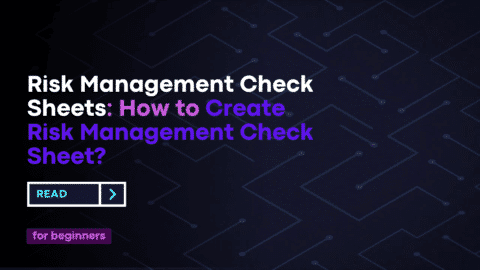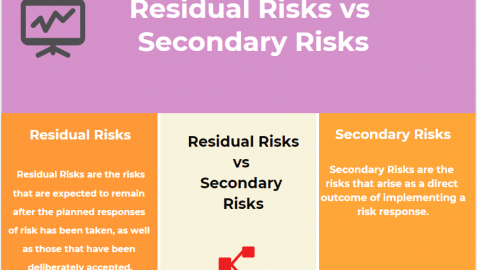Risk Response Strategies for Positive Risks
A risk defined as an unforeseen event that may have positive or negative effects on the project’s objectives in case of its occurrence. Since the risks have either positive or negative impacts, they can be grouped into two major categories. As the name suggests, positive risks have positive impacts on the project’s goals so that the project team tries to make them happen by implementing response strategies. On the other hand, negative risks have unfavorable impacts on the project’s goals consequently, the project team tries to minimize their harmful effects. In this article, we will discuss how to select the correct risk response strategy to deal with positive risks by using real-life examples.
Table of Contents
Risk Response Strategies
Risk management is a critical step of project management and the main goal of the Plan Risk Responses process is to establish the most effective strategies for managing project risks.
Before implementing a response strategy, the first thing to do is identifying project risks and documenting them in a Risk Register. Then, you will perform a qualitative risk analysis to prioritize identified risks with the help of a pre-defined rating scale. After that, you will decide the correct risk response strategy to deal with risks.
Typically, risk response strategies can be classified into two major categories;
- Strategies for responding to negative risks, or threats
- Strategies for responding to positive risks, or opportunities.
Strategies to deal with risks may change depending on the type of risk.
Below are the strategies to deal with the negative risks according to the PMBOK® Guide.
- Escalate
- Mitigate
- Transfer
- Avoid
- Accept
The PMBOK® Guide specifies the below positive risk response strategies.
- Escalate
- Enhance
- Exploit
- Accept
- Share
Positive risks have a positive effect on project goals, therefore methods to deal with them will focus on increasing the chances of them arising.
What are the Risk Response Strategies for Positive Risks?
Positive risks or opportunities have favorable impacts on the project objectives. Therefore the project team will always expect them to happen. Exploit is the most desired strategy among others because it provides more benefits. All the same, accept is the least desired one because you can not take any action, everything is out of your control.
Let’s analyze each strategy in detail.
Escalate
The escalate risk response strategy can be used when the opportunity is outside the scope of the project or the project manager’s authority level is insufficient to develop a response. Managers at the program or portfolio level deal with the opportunities by using the escalate strategy.
Simply put, if the project manager’s authority level is not sufficient to realize the opportunity he will contact top management to handle it. So the opportunity will be escalated to the top management.
Once the opportunity is escalated by them, the project team will not take any action to deal with it. These opportunities may be recorded in the risk register for informational purposes.
For example, you are managing a hospital construction project and the client came to your office and told that they are planning to have a new hospital in another region. Then asked if your company is interested in bidding for the construction work. You contacted your program manager and informed him of this opportunity.
Enhance
The enhance risk response strategy analyzes the root cause of the positive risk and tries to increase the probability and the positive impacts of it.
For example, you are managing a power plant project which should be completed in 24 months. According to the contract, if you complete it earlier, you will earn a bonus payment. But you are aware of the high cost of early completion thus, you decided to take a less aggressive approach to make the risk at least more probable to happen. Therefore you decided to motivate your project team and promise them a bonus payment for early completion.
Exploit
The exploit risk response strategy aims to eliminate uncertainty by making the opportunity absolutely happen.
Let’s analyze the same example from a different point of view.
You are managing a power plant project and you are required to complete the project in 24 months. According to the contract, you will earn a bonus payment in case of early completion. Therefore, you decided to take a more aggressive approach to make the risk certainly happen. You decided to transfer your resources to this project from other projects of your organization and you pay overtime to salaried employees in order to exploit this situation.
Accept
The accept response strategy is to take advantage of the opportunity if it arises without taking any action to realize the opportunity.
For example, you are managing a housing project and there is a highway project very close to you. The project manager of the highway project came to your site and proposed you sell backfill material at a low price. You evaluated this situation and accepted.
Accepting strategy is applicable to both negative and positive Risks.
Share
The share response strategy is to assign the ownership of the opportunity to a third party who is capable of capturing the opportunity for the benefit of the project.
For example, you are planning to participate in a tender but the scope of work requires a certain technical capability. Therefore you will persuade a company that has a certain technical capability to collaborate with your organization.
Do You Need To Deal With All The Risks?
Is it possible for project teams to deal with all the risks equally? The answer is no. Because you don’t have funds, time and resources. Therefore, you need to prioritize each identified risk by scoring. After that your team and stakeholders evaluate possible responses for each prioritized risk.
As a result, you will see that some risks require extra resources, funds or action. Developing the most effective strategy depends on your organizations risk tolerance and thresholds.
It is important to communicate the possible options with project sponsor and key stakeholders to get their support.
At the end of this process, risk response plans will require updates on the project scope, budget, schedule and resource quantities if needed.
Summary
These four strategies can be used to manage positive risks. The project manager decides which strategy type is appropriate considering the risk type and the circumstances of the project. If necessary responses are not implemented, the risk management process will fail, and the chances of the project achieving its goals will be reduced.
In this article, we discuss each positive risk response strategy and key aspects. We hope that it will be useful for the applicants who will take the PMI-RMP and PMP Certification Exam.
See Also
Negative Risk Response Strategies

Francois Simosa is the head of training for the Gragados Training Associates, which provides special project management and risk management training programs.
















I am surprised about this post. It has an excellent presentation, and a clear layout, and the information is meaningful to me. Thank you very much